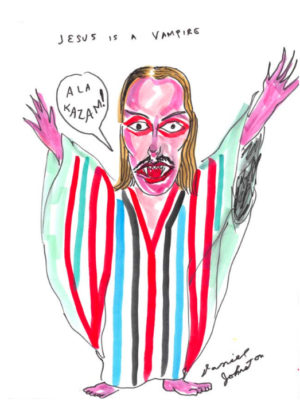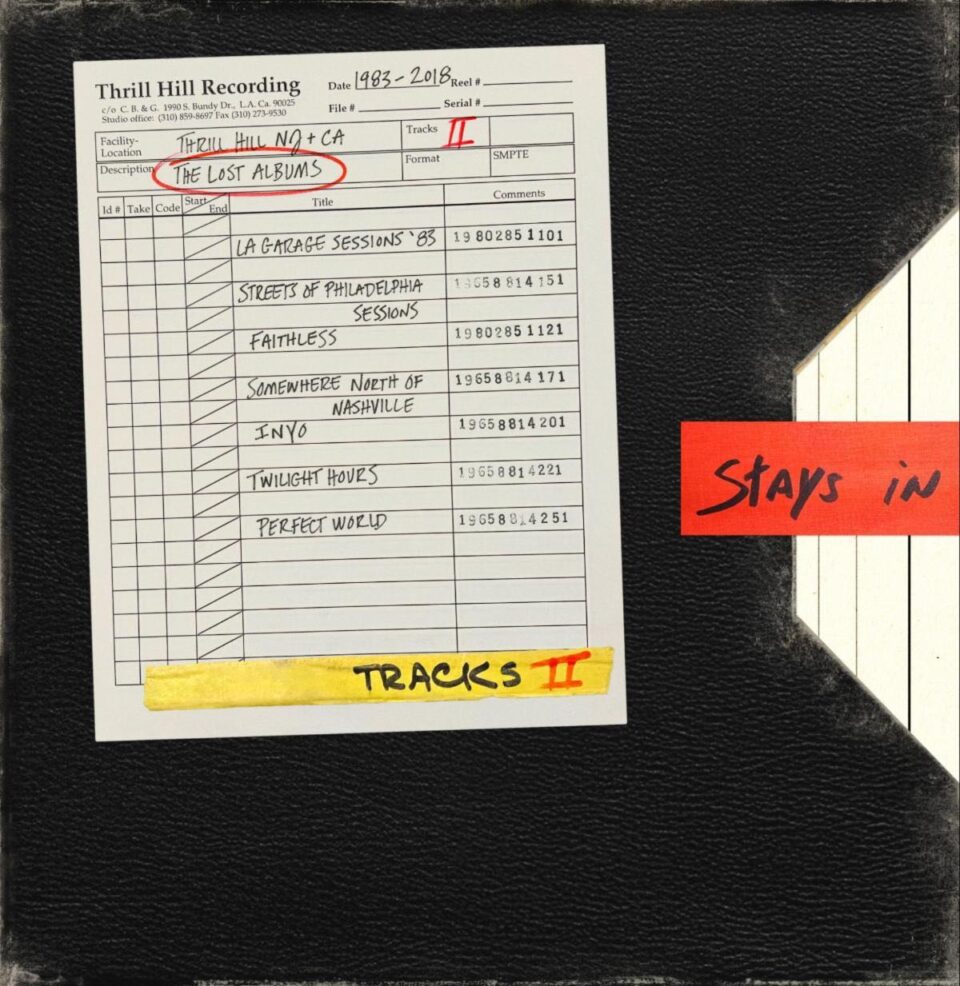From the time Nirvana’s Kurt Cobain wore Daniel Johnston’s artwork on a t-shirt (to say nothing of last year’s meta moment when Kid Cudi got a tattoo of Cobain wearing Daniel Johnston’s artwork on a t-shirt), the eccentric Texan singer-songwriter became as famed for his squiggly line drawings and pure-as-snow paintings as he was for his music and battles with mental health issues. When he died suddenly, at age 58 in 2019, Johnston left behind 17 albums, the reverence of musicians like Tom Waits, Sonic Youth, and The Flaming Lips, one great documentary in 2005’s The Devil and Daniel Johnston, and a body of artwork that’s brutal and funny, poignant and sad, distanced and dear, and all coming from a place few of us could truly understand, yet all of us would delight in.
With that, any newly uncovered artwork from Daniel’s family (the executors of his estate) and a fresh host website—Story of an Artist—is worth its weight in gold and crudely lined magic markers. That’s especially true when you consider Story of an Artist’s recent exhibitions (NYC’s Outsider Art Fair at Electric Lady Studios with Pee Wee Herman/Zappa artist-curator Gary Panter) and its unique ties to the studio-house that Jimi Hendrix built right before he died.
Lee Foster, now a managing partner at Electric Lady, got to the studio as an intern, without much history in regard to high or low arts, or even curatorial skills. “I got to Electric Lady at an early age, and have spent my whole career here,” he says of his start back in 2000. “It’s all been a matter of timing, one where the industry was changing with the introduction of ProTools and Napster, both which greatly affected the music industry.” At age 27, he was tasked with making an ailing Electric Lady healthy. “So I did… And now I’m one of the owners here.”

What did catch Foster’s eye when it came to art and turning Electric Lady into a part-time gallery space, Foster found Daniel Johnston’s artwork in a funny way, one similar to how he found other recording musicians’ art. “One thing that happens when an artist sits in a studio for 12 to 14 hours a day is that they start to doodle. I began collecting their work.” That meant drawings from the late Ric Ocasek, Devendra Banhart, Patti Smith, Adam Green, and more in Foster’s collection. “These are representations of the bond and friendships I formed with these musicians over the years,” says Foster of his doodle roster. “And Daniel was a top of the mountain moment for me. Far and away, I have more of Daniel’s work than I do anyone else.”
It wasn’t until Johnston had passed that Foster learned you could buy the singer’s artwork—that it was a real commodity with real collectors, and that the Johnston family was directly involved with its maintenance and curation. Brother Dick Johnston not only brought Foster into the fold, he walked the New Yorker through Daniel’s homestead and made him part of the family. “It was a big job for Dick to have been suddenly tasked with overseeing his brother’s legacy—all of it, from Daniel’s art and music to his notebooks and poetry.” Foster describes his deep collection of Daniel Johnston work as being akin to going down a rabbit hole, involving trips to Texas and seeing the family. “It became an obsession—still is. I can’t stop poring over it, and looking at it all.” With that, between his personal collection and that of Electric Lady’s gallery, Foster claims to hold dozens of devilish Daniel Johnston originals.
Foster acknowledges that, like Picasso, there are several Johnston periods to pick from, all quite different. There isn’t “an elegant answer” as to why any period or portrait touches Foster. “It just makes me laugh, makes me sad, makes me curious about what he was thinking in that moment. I love his artwork and his mind—the universe that was going on inside of Daniel’s head. It is singular. It is dramatic. It tells a story.”
“One thing that happens when an artist sits in a studio for 12 to 14 hours a day is that they start to doodle. These are representations of the bond and friendships I formed with these musicians over the years, and Daniel was a top of the mountain moment for me. Far and away, I have more of Daniel’s work than I do anyone else.”
Electric Lady and the Johnston family first partnered for the Honey, I Sure Miss You compilation, an acknowledgment of the first anniversary of Daniel’s death, with artists covering Johnston’s musical legacy. Johnston’s one-time manager and longtime friend Jeff Tartikoff suggested getting together with the Andrew Edlin Gallery, the owner of NYC’s Outsider Art Fair. With the dream of turning Electric Lady into a gallery space, Foster introduced audiences to the glories of Hendrix’s studio space and its history together with seeing Johnston’s wriggly art.
And though Foster is but a peripheral aspect of the upcoming exhibition at Contemporary Austin with “Daniel Johnston: I Live My Broken Dreams,” the first and “most immersive” major museum survey of his visual art and music (September 11, 2021 through March 20, 2022), Story of an Artist is a fully functioning and flourishing new, interactive web repository presenting newly found versions and rare Johnston creations, from the Captain America series, to those capturing Casper-like ghosts, mischievous geese, half-headed men, multi-eyed boxers, and more. “Looking at Daniel’s art, and valuing Daniel’s art, we’ve further proven that there is a market for his vision, and Story of an Artist is an extension of that—you can see a good variety of his work, and purchase it.”
While additional items are incoming, along with educational facets, Foster’s site is a one-stop-shopping-and-wowing web gallery most all-encompassing, filled with wonder. “It’s more than a souvenir to music fans—it’s art.” When we share rhapsodies on the breadth of his art and, in particular, Johnston’s Captain America, it’s there that Foster focuses on the artist’s legendary history with his father (a fighter pilot in World War II), and how Johnston made a history of heroism. “This is his universe, and there are so many planets in that universe—so many stars—to discover, whether it’s the early innocent work or when he honed in on his technical craft and fulfilled his vision.” FL










